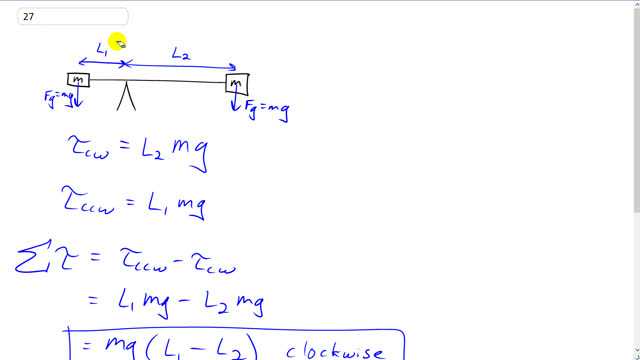
Two blocks, each of mass , are attached to the ends of a massless rod which pivots as shown in Fig. 8–43. Initially the rod is held in the horizontal position and then released. Calculate the magnitude and direction of the net torque on this system when it is first released.


In order to watch this solution you need to have a subscription.
This is Giancoli Answers with Mr. Dychko. This mass is at a position L 2 away from the pivot and then this other mass is at a shorter distance L 1 from the pivot and this rod is horizontal which means that the weight of each mass is perpendicular to the lever arm already— the weight being straight down— and so we have the torque clockwise is due to this mass because it's rotating this whole system in the clockwise direction this way. And so the clockwise torque is L, 2 this lever arm multiplied by the weight of this mass mg and then the counter-clockwise torque which tends to rotate the system in this way is due to the left hand mass which has a counter-clockwise torque then of L 1 times mg. So the total torque is the counter-clockwise minus the clockwise. So we have L 1mg for the counter-clockwise torque minus L 2mg for the clockwise torque and factor out the mg, we have mg times L 1 minus L 2 and this net result will be clockwise since L 2 is longer than L 1 so this is gonna be negative since L 2 is bigger than L 1 and negative means clockwise.
This answer is wrong it should be L2-L1 as it says in the book. why am i paying for a service with misleading information.
Hi Vossdrummer, the order of L2 and L1 depends on which direction one defines as positive. The usual convention is to take counter-clockwise as positive, in which case L1-L2 is correct. If one chooses clockwise to be positive, which is perfectly valid, but needs to be explicitly mentioned since it's different from the usual convention, then L2-L1 would be correct as you mentioned.
All the best with your studies,
Mr. Dychko